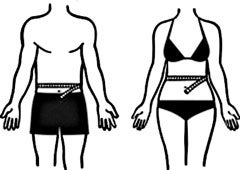Welcome to Your Breast Health Blog!
This blog is your resource for understanding breast health, addressing common concerns, and staying informed about the latest research in breast care.
Being overweight can increase your risk of cancer and other diseases
You can lower your risk of cancer by enjoying a healthy diet, being physically active every day and maintaining a healthy body weight.
Studies show being overweight, physically inactive and not eating well increases your risk of developing cancer.
Being overweight or obese also increases your risk of type 2 diabetes, cardiovascular disease, high blood pressure, gall bladder disease, gout, impaired fertility, lower back pain, osteoarthritis and many other conditions.
Since the 1980s there has been a steady increase in the number of Australians who are classed as overweight or obese. At least 67% of adults and 25% of children are now considered overweight or obese.
Being overweight or obese increases your risk of developing certain types of cancer, including common forms such as bowel and (post-menopausal) breast cancer, as well as cancers of the endometrium, kidney and oesophagus. Three percent of cancer deaths are attributed to having a Body Mass Index over 25.
The Body Mass Index, or BMI, is a measurement used to assess people’s body weight – a score over 25 is classed as overweight and a score over 30 is obese.
Waist circumference is another way to measure body weight. Men should aim for a waist circumference below 94cm. Women should aim for a waist circumference below 80cm.
To maintain a healthy body weight, eat a balanced diet that only contains as much energy (kilojoules or calories) as you use each day.
If your BMI is above 25, you should also try to increase your level of physical activity.
Use both the body mass index (BMI) and waist circumference to check body fatness.
BMI is a measure of your body weight in relation to your height. To work out your BMI, you need to know your weight (in kilograms) and your height (in metres).

Steve weighs 82kg and is 1.74 metres tall. To calculate his BMI, divide his weight by his height in metres squared: 82/(1.74 x 1.74) = 27kg/m2
Steve’s BMI is 27 and is in the overweight range.
Ideally your BMI should be between 18.5 and 25, in the healthy weight range.
However, the specific cut-off measurements of BMI may not be suitable for all ethnic groups, who may have equivalent levels of risk at a lower BMI or higher BMI.
For some diseases including postmenopausal breast cancer, fat carried around the abdomen and waist is a greater risk than fat carried on the hips and thighs for type.

Take your waist circumference measurement at the narrowest point between the lower rib and the top of the hips (the iliac crest) at the end of a normal breath.
If you are overweight or obese it may be because you are eating more than you need for your level of activity.
To maintain a healthy weight, enjoy regular physical activity and eat according to your needs. Make your diet mostly fruit, vegetables, cereals and other low-fat foods.
Losing weight to reach a healthy weight for your height isn’t easy, however any weight loss will be beneficial.
Popular weight loss diets generally don’t work in the long term. It is better to make small changes to your diet and physical activity habits that you can maintain for a lifetime.
Plan to:
Remember, if you have any concerns or questions, please contact your doctor.
Poor nutrition and lack of physical activity increase your risk of developing certain cancers. Encouraging employees to be physically active and to eat healthy food is an important step toward reducing the risk of cancer in your workplace.
Some tips:
This blog is your resource for understanding breast health, addressing common concerns, and staying informed about the latest research in breast care.
Preventative health is for everyone – what should you be doing? Prevention is better than cure and starts at any age. Take a risk quiz


What the screening test results mean for you

Around 14,000 new cases of bowel cancer are diagnosed each year in Australia.
The chance of a woman up to age 85 developing breast cancer is one in eight.
Our quizzes help to determine your risk of disease and will remind you of essential check-ups (if you should need one).
At the end of the quiz you will be presented with a recommendation based on your answers.

We work with


Disclaimer
Doctors.com.au does not warrant or hold any responsibility for this fact sheet. Fact sheets are provided to doctors.com.au from relevant third party partners and companies.
Doctors.com.au will not be held responsible or liable for any errors or omissions that may be found in any of the information on this fact sheet, and you are encouraged to consult other sources to confirm the information, and in the event that medical treatment is required, to take professional expert advice from a legally qualified and appropriately experienced medical practitioner.
 Need a doctor now? Speak to a GP in minutes via phone or video consult.
Need a doctor now? Speak to a GP in minutes via phone or video consult.